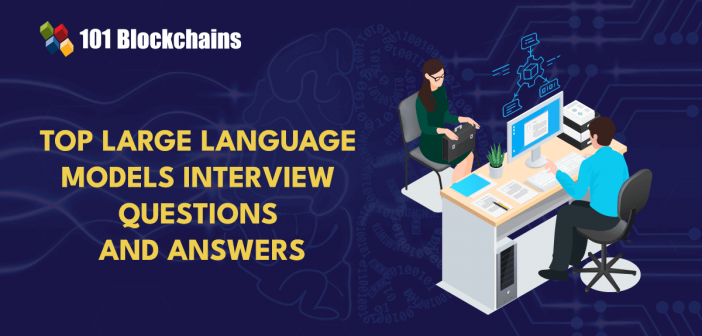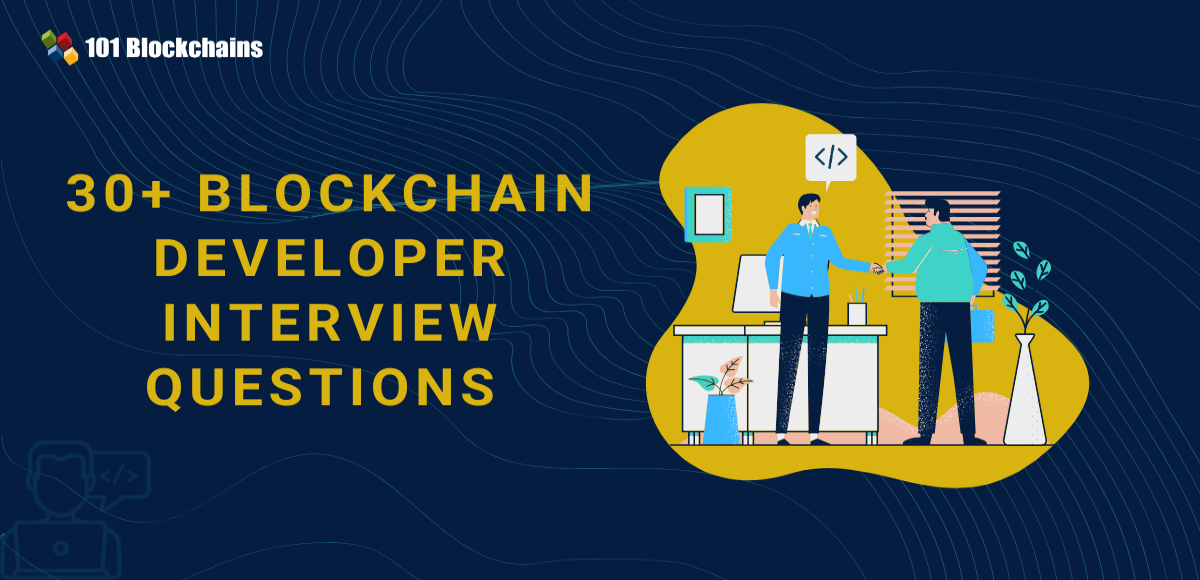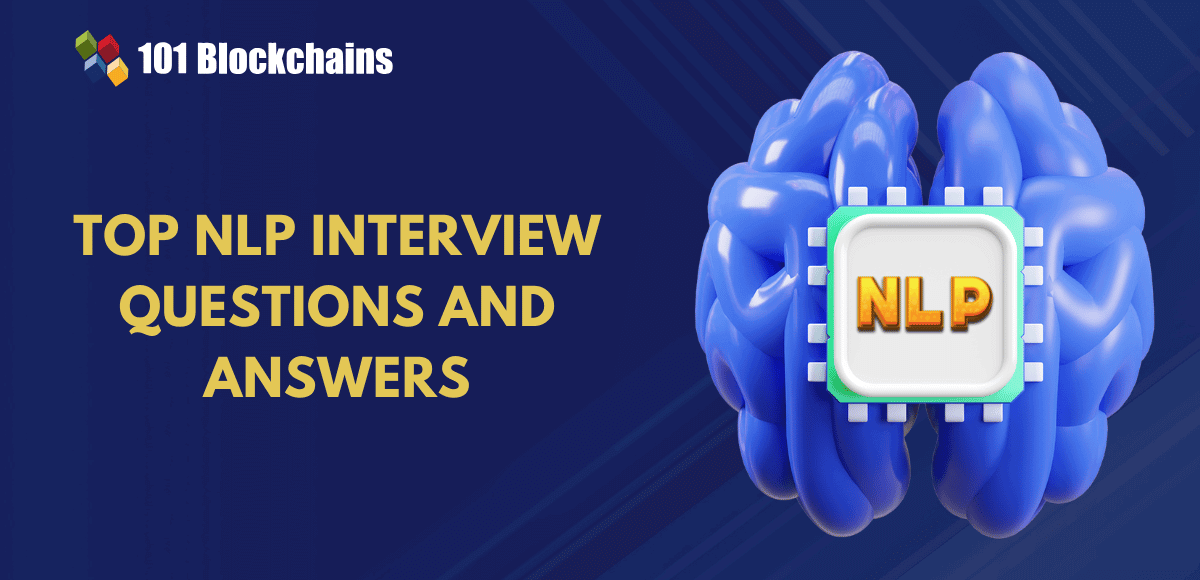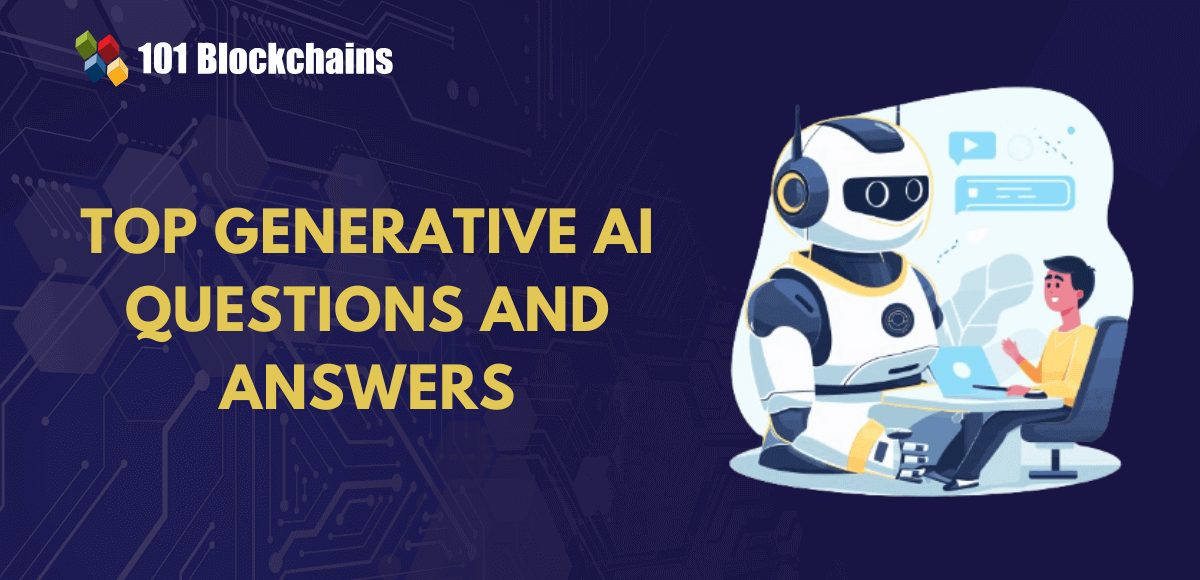Learn how blockchain truly works, master key definitions, and uncover what makes smart contracts so "smart." Dive into the fundamentals, gain valuable insights, and start your blockchain journey today!

- Interview Preparation
Georgia Weston
- on December 29, 2023
Top 20 Large Language Models (LLMs) Interview Questions And Answers
Generative AI and large language models, or LLMs, have become the hottest topics in the domain of AI. With the arrival of ChatGPT in late 2022, discussions about LLMs and their potential garnered the attention of industry experts. Any individual preparing for machine learning and data science jobs must have expertise in LLMs. The top LLM interview questions and answers serve as effective tools for evaluating the effectiveness of a candidate for jobs in the AI ecosystem. By 2027, the global AI market could have a total capitalization of almost $407 billion. In the US alone, more than 115 million people are expected to use generative AI by 2025. Do you know the reason for such a sporadic rise in the adoption of generative AI?
ChatGPT had almost 25 million daily visitors within three months of its launch. Around 66% of people worldwide believe that AI products and services are likely to have a significant impact on their lives in the coming years. According to IBM, around 34% of companies use AI, and 42% of companies have been experimenting with AI.
As a matter of fact, around 22% of participants in a McKinsey survey reported that they used generative AI regularly for their work. With the growing popularity of generative AI and large language models, it is reasonable to believe that they are core elements of the continuously expanding AI ecosystem. Let us learn about the top interview questions that could test your LLM expertise.
Best LLM Interview Questions and Answers
Generative AI experts could earn an annual salary of $900,000, as advertised by Netflix, for the role of a product manager on their ML platform team. On the other hand, the average annual salary with other generative AI roles can vary between $130,000 and $280,000. Therefore, you must search for responses to “How do I prepare for an LLM interview?” and pursue the right path. Interestingly, you should also complement your preparations for generative AI jobs with interview questions and answers about LLMs. Here is an outline of the best LLM interview questions and answers for generative AI jobs.
LLM Interview Questions and Answers for Beginners
The first set of interview questions for LLM concepts would focus on the fundamental aspects of large language models. LLM questions for beginners would help interviewers verify whether they know the meaning and functionality of large language models. Let us take a look at the most popular interview questions and answers about LLMs for beginners.
1. What are Large Language Models?
One of the first additions among the most popular LLM interview questions would revolve around its definition. Large Language Models, or LLMs, are AI models tailored for understanding and generating human language. As compared to traditional language models, which rely on a predefined set of rules, LLMs utilize machine learning algorithms alongside massive volumes of training data for independent learning and generating language patterns. LLMs generally include deep neural networks with different layers and parameters that could help them learn about complex patterns and relationships in language data. Popular examples of large language models include GPT-3.5 and BERT.
Enroll now in the Mastering Generative AI with LLMs Course to discover the different ways of using generative AI models to solve real-world problems.
2. What are the popular uses of Large Language Models?
The list of interview questions about LLMs would be incomplete without referring to their uses. If you want to find the answers to “How do I prepare for an LLM interview?” you should know about the applications of LLMs in different NLP tasks. LLMs could serve as valuable tools for Natural Language Processing or NLP tasks such as text generation, text classification, translation, text completion, and summarization. In addition, LLMs could also help in building dialog systems or question-and-answer systems. LLMs are ideal choices for any application that demands understanding and generation of natural language.
3. What are the components of the LLM architecture?
The collection of best large language models interview questions and answers is incomplete without reflecting on their architecture. LLM architecture includes a multi-layered neural network in which every layer learns the complex features associated with language data progressively.
In such networks, the fundamental building block is a node or a neuron. It receives inputs from other neurons or nodes and generates output according to its learning parameters. The most common type of LLM architecture is the transformer architecture, which includes an encoder and a decoder. One of the most popular examples of transformer architecture in LLMs is GPT-3.5.
4. What are the benefits of LLMs?
The benefits of LLMs can outshine conventional NLP techniques. Most of the interview questions for LLM jobs reflect on how LLMs could revolutionize AI use cases. Interestingly, LLMs can provide a broad range of improvements for NLP tasks in AI, such as better performance, flexibility, and human-like natural language generation. In addition, LLMs provide the assurance of accessibility and generalization for performing a broad range of tasks.
Excited to learn about the fundamentals of Bard AI, its evolution, common tools, and business use cases? Enroll now in the Google Bard AI Course
5. Do LLMs have any setbacks?
The top LLM interview questions and answers would not only test your knowledge of the positive aspects of LLMs but also their negative aspects. The prominent challenges with LLMs include the high development and operational costs. In addition, LLMs utilize billions of parameters, which increases the complexity of working with them. Large language models are also vulnerable to concerns of bias in training data and AI hallucination.
6. What is the primary goal of LLMs?
Large language models could serve as useful tools for the automatic execution of different NLP tasks. However, the most popular LLM interview questions would draw attention to the primary objective behind LLMs. Large language models focus on learning patterns in text data and using the insights for performing NLP tasks.
The primary goals of LLMs revolve around improving the accuracy and efficiency of outputs in different NLP use cases. LLMs can support faster and more efficient processing of large volumes of data, which validates their application for real-time applications such as customer service chatbots.
7. How many types of LLMs are there?
You can come across multiple types of LLMs, which can be different in terms of architecture and their training data. Some of the popular variants of LLMs include transformer-based models, encoder-decoder models, hybrid models, RNN-based models, multilingual models, and task-specific models. Each LLM variant uses a distinct architecture for learning from training data and serves different use cases.
Want to understand the importance of ethics in AI, ethical frameworks, principles, and challenges? Enroll now in the Ethics Of Artificial Intelligence (AI) Course
8. How is training different from fine-tuning?
Training an LLM and fine-tuning an LLM are completely different things. The best large language models interview questions and answers would test your understanding of the fundamental concepts of LLMs with a different approach. Training an LLM focuses on training the model with a large collection of text data. On the other hand, fine-tuning LLMs involves the training of a pre-trained LLM on a limited dataset for a specific task.
9. Do you know anything about BERT?
BERT, or Bidirectional Encoder Representations from Transformers, is a natural language processing model that was created by Google. The model follows the transformer architecture and has been pre-trained with unsupervised data. As a result, it can learn natural language representations and could be fine-tuned for addressing specific tasks. BERT learns the bidirectional representations of language, which ensures a better understanding of the context and complexities associated with the language.
10. What is included in the working mechanism of BERT?
The top LLM interview questions and answers could also dig deeper into the working mechanisms of LLMs, such as BERT. The working mechanism of BERT involves training of a deep neural network through unsupervised learning on a massive collection of unlabeled text data.
BERT involves two distinct tasks in the pre-training process, such as masked language modeling and sentence prediction. Masked language modeling helps the model in learning bidirectional representations of language. Next sentence prediction helps with a better understanding of structure of language and the relationship between sentences.
Identify new ways to leverage the full potential of generative AI in business use cases and become an expert in generative AI technologies with Generative AI Skill Path
LLM Interview Questions for Experienced Candidates
The next set of interview questions on LLMs would target experienced candidates. Candidates with technical knowledge of LLMs can also have doubts like “How do I prepare for an LLM interview?” or the type of questions in the advanced stages of the interview. Here are some of the top interview questions on LLMs for experienced interview candidates.
11. What is the impact of transformer architecture on LLMs?
Transformer architectures have a major influence on LLMs by providing significant improvements over conventional neural network architectures. Transformer architectures have improved LLMs by introducing parallelization, self-attention mechanisms, transfer learning, and long-term dependencies.
12. How is the encoder different from the decoder?
The encoder and the decoder are two significant components in the transformer architecture for large language models. Both of them have distinct roles in sequential data processing. The encoder converts the input into cryptic representations. On the other hand, the decoder would use the encoder output and previous elements in the encoder output sequence for generating the output.
13. What is gradient descent in LLM?
The most popular LLM interview questions would also test your knowledge about terms like gradient descent, which are not used regularly in discussions about AI. Gradient descent refers to an optimization algorithm for LLMs, which helps in updating the parameters of the models during training. The primary objective of gradient descent in LLMs focuses on identifying the model parameters that could minimize a specific loss function.
14. How can optimization algorithms help LLMs?
Optimization algorithms such as gradient descent help LLMs by finding the values of model parameters that could lead to the best results in a specific task. The common approach for implementing optimization algorithms focuses on reducing a loss function. The loss function provides a measure of the difference between the desired outputs and predictions of a model. Other popular examples of optimization algorithms include RMSProp and Adam.
15. What do you know about corpus in LLMs?
The common interview questions for LLM jobs would also ask about simple yet significant terms such as corpus. It is a collection of text data that helps in the training or evaluation of a large language model. You can think of a corpus as the representative sample of a specific language or domain of tasks. LLMs select a large and diverse corpus for understanding the variations and nuances in natural language.
16. Do you know any popular corpus used for training LLMs?
You can come across multiple entries among the popular corpus sets for training LLMs. The most notable corpus of training data includes Wikipedia, Google News, and OpenWebText. Other examples of the corpus used for training LLMs include Common Crawl, COCO Captions, and BooksCorpus.
17. What is the importance of transfer learning for LLMs?
The outline of best large language models interview questions and answers would also draw your attention toward concepts like transfer learning. Pre-trained LLM models like GPT-3.5 teach the model how to develop a basic interpretation of the problem and offer generic solutions. Transfer learning helps in transferring the learning to other contexts that could help in customizing the model to your specific needs without retraining the whole model again.
18. What is a hyperparameter?
A hyperparameter refers to a parameter that has been set prior to the initiation of the training process. It also takes control over the behavior of the training platform. The developer or the researcher sets the hyperparameter according to their prior knowledge or through trial-and-error experiments. Some of the notable examples of hyperparameters include network architecture, batch size, regularization strength, and learning rate.
19. What are the preventive measures against overfitting and underfitting in LLMs?
Overfitting and underfitting are the most prominent challenges for training large language models. You can address them by using different techniques such as hyperparameter tuning, regularization, and dropout. In addition, early stopping and increasing the size of the training data can also help in avoiding overfitting and underfitting.
20. Do you know about LLM beam search?
The list of top LLM interview questions and answers might also bring surprises with questions on relatively undiscussed terms like beam search. LLM beam search refers to a decoding algorithm that can help in generating text from large language models. It focuses on finding the most probable sequence of words with a specific collection of input tokens. The algorithm functions through iterative creation of the most relevant sequence of words, token by token.
Become a master of generative AI applications by developing expert-level skills in prompt engineering with Prompt Engineer Career Path
Conclusion
The collection of most popular LLM interview questions shows that you must develop special skills to answer such interview questions. Each question would test how much you know about LLMs and how to implement them in real-world applications. On top of it, the different categories of interview questions according to level of expertise provide an all-round boost to your preparations for generative AI jobs. Learn more about generative AI and LLMs with professional training resources right now.







